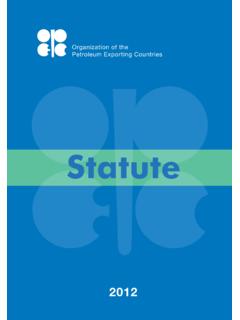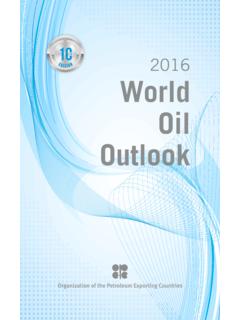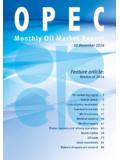Transcription of OPEC
1 Monthly Oil Market ReportOPEC13 November 2017 Feature article:Recent Developments in Global Oil InventoriesOil market highlightsFeature articleCrude oil price movementsCommodity marketsWorld economyWorld oil demandWorld oil supplyProduct markets and refinery operationsTanker marketOil tradeStock movementsBalance of supply and demandiiii181130415863677481 Organization of the Petroleum Exporting CountriesHelferstorferstrasse 17, A-1010 Vienna, AustriaE-mail: prid(at) : Market Highlights OPEC Monthly Oil Market Report November 2017 i Oil Market Highlights Crude Oil Price Movements The OPEC Reference Basket averaged $ in October, gaining $ over the previous month and reaching the highest value in more than two-and-a-half years, with a year-to-date average of $ Crude futures also reached levels not seen since mid-2015. ICE Brent ended $ higher at $ , while NYMEX WTI increased $ , reaching $ , keeping the Brent-WTI spread above $6/b.
2 Prices have been supported by rising global demand data and expectations that major producing nations will extend a deal to adjust output and bring the oil market to a balance. Hedge funds raised net long positions in NYMEX WTI and ICE Brent futures and options by 29,456 and 21,592 contracts, respectively, to 281,244 and 530,237 lots. Brent and Dubai remained in backwardation, while the WTI contango eased. Sweet/sour differentials narrowed in Asia and Europe, but widened on the US Gulf Coast. World Economy The global economic growth dynamic has continued its momentum, with the forecast for 2017 revised up to , from in last month s report. Similarly, the 2018 forecast has been adjusted higher as well to stand at , compared to in the previous month. Particularly OECD economic growth in 2017 was better than expected so far.
3 The OECD is seen growing by upwardly revised in 2017 and in 2018. Good momentum and a potential tax reform in the US, the ongoing dynamic in the Euro-zone and to some extent in Japan, solid growth in China and India and an improving situation in Russia and Brazil are supporting the growth trend in the short-term. World Oil Demand World oil demand growth is expected to rise by mb/d in 2017 after an upward adjustment of 74 tb/d to account for the better-than-expected performance of China in 3Q17. In 2018, world oil demand is foreseen reaching mb/d, around 130 tb/d higher than in the previous assessment. World Oil Supply Non-OPEC oil supply is now projected to grow by mb/d y-o-y in 2017, representing a downward revision of mb/d from last month s report. For 2018, growth in non-OPEC oil supply has also been revised down by mb/d to stand at mb/d.
4 OPEC NGLs and non-conventional liquids are expected to grow by mb/d in 2018, following an increase of mb/d in 2017. In October 2017, OPEC crude oil production decreased by 151 tb/d, according to secondary sources, to average mb/d. Product Markets and Refining Operations Product markets in the Atlantic Basin weakened in October due to seasonally-lower gasoline demand following the end of US driving season. Nonetheless, US refining margins have exhibited some improvement y-o-y on the back of firm product demand and amid low stock levels. In Europe, solid middle-of-the-barrel demand offset weakness at the top and bottom. Product markets in Asia also weakened slightly, but remained at healthy levels, supported by the onset of refinery maintenance. Tanker Market Sentiment in the dirty tanker market generally strengthened in October, as freight rates for different classes showed improvements on most major trading routes.
5 Average dirty tanker spot freight rates rose 16% compared to the previous month, on the back of improved seasonal tonnage demand, as well as port and weather delays, among other factors. Despite healthy gains in October, the shipping market remains in surplus, capping further increases in spot freight rates. Meanwhile, clean tanker freight rates experienced a relative decline, although remaining above the levels of the same month last year. Stock Movements Total OECD commercial oil stocks fell in September to stand at 2,985 mb. At this level, OECD commercial oil stocks are 154 mb above the latest five-year average. Crude and products stocks indicated a surplus of around 129 mb and 25 mb, respectively, above the seasonal norm. In terms of days of forward cover, OECD commercial stocks stood at days in September, some days higher than the latest five-year average.
6 Balance of Supply and Demand Based on the current global oil supply/demand balance, OPEC crude in 2017 is estimated at mb/d, around mb/d higher than in 2016. OPEC crude in 2018 is estimated at mb/d, about mb/d higher than in 2017. Oil Market Highlights ii OPEC Monthly Oil Market Report November 2017 Feature Article OPEC Monthly Oil Market Report November 2017 iii Feature Article Recent developments in global oil inventories Over the years 2014 through 2016, global oil inventories grew rapidly, as global oil supply outpaced world oil demand. During the same period, the crude futures forward curve flipped into a prolonged contango for the first time since 2010, providing an economic incentive to store significant volumes of crude at sea. By February 2016, OECD commercial stock levels a key indicator of the state of the oil market reached at a record-high of more than 380 mb over the five-year average, indicating the huge excess of supply in the market.
7 The landmark production adjustment decision taken by the OPEC and non-OPEC participating oil producing nations at the end of 2016, known as the Declaration of Cooperation, together with its renewal in May this year, were necessary responses to the urgent need to bring forward market rebalancing. These distinguished efforts focused on accelerating the drawdown of the global stock overhang in order to hasten the return of sustainable oil market stability. As a result, total OECD commercial stocks saw a drop of 83 mb in the first three quarters of this year, compared to a build of 38 mb in the same period last year and a build of 100 mb compared to the average level seen in the last five years (2012-2016). In the first three quarters of 2017, crude inventories have fallen by 23 mb, while refined product stocks in the OECD have declined by 60 mb, driven mainly by improving demand in OECD countries.
8 In the first three quarters of 2017, the stock draw came as global oil demand growth rose by mb/d compared to the same period in 2016, outpacing the mb/d net increase in global oil supply over the same period (Graph 1). It should be noted that the rise in global supply came solely from the countries outside the Declaration of Cooperation. During the first Graph 1: World oil demand and supply average, 1Q-3Q17 vs. 1Q-3Q16 three quarters of 2017, OPEC-12 reduced their average production by mb/d and non-OPEC participants by mb/d compared to the same period last year, while other non-OPEC oil producing countries increased their supply by mb/d. It should be highlighted that during the same period the conformity of the OPEC and non-OPEC participants reached 102% compared to their agreed reference months. The excess overhang has fallen considerably, with the difference to the five-year average reduced by around 183 mb since the beginning of this year to stand at 154 mb in September (Graph 2).
9 Crude and products indicated surpluses of 129 mb and 25 mb above the seasonal norm, respectively. On regional basis, the bulk of this overhang is located in OECD Americas followed by OECD Europe. OECD Asia Pacific has remained broadly in line with the five-year average. Amid improving OECD demand, inventories in terms of days of forward cover have fallen from more than 65 days in mid-2016 to currently stand at days. Similarly, the deviation with the five-year average has been reducing from days to just days. Graph 2: OECD commercial oil inventories, difference to 5-year average Meanwhile, floating storage for crude and products has been also on a declining trend since the beginning of this year, dropping by around 50 mb to 87 mb at the end of October 2017. This trend has been accelerated recently by a shift in the ICE Brent forward curve to backwardation, encouraging de-stocking.
10 Looking ahead, the high conformity levels of participating OPEC and non-OPEC producing countries, in accordance with the Declaration Cooperation , have clearly played a key role in supporting stability in the oil market and placing it on a more sustainable path. As a part of this process of cooperation, OPEC and participating non-OPEC countries will meet at the end of this month to assess market developments and consider how best to continue these efforts in the coming year. oilsupplyWorld oildemandSource: OPEC mb/dNon-OPEC participantsOther non-OPECL ibya & NigeriaOPEC NGLsNet change = mb/d12925154-2000200400 Jan 14 May 14 Sep 14 Jan 15 May 15 Sep 15 Jan 16 May 16 Sep 16 Jan 17 May 17 Sep 17mbCrudeProductsTotalSources: Argus Media, EIA,Euroilstock, IEA, METIand OPEC 17 Feature Article iv OPEC Monthly Oil Market Report November 2017 Table of Contents OPEC Monthly Oil Market Report November 2017 v Table of Contents Oil Market Highlights i Feature Article iii Recent developments in global oil inventories iii Crude Oil Price Movements 1 OPEC Reference Basket 1 The oil futures market 3 The futures market structure 4 The light sweet/medium sour crude spread 6 Impact of US dollar and inflation on oil prices 7 Commodity Markets 8 Trends in selected commodity markets 8 Investment flows into commodities 9 World Economy 11 OECD 11 Non-OECD 18 World Oil Demand 30 World oil demand in 2017 and 2018 30 OECD 31 Non-OECD 35 China 36 World Oil Supply 41 Monthly revisions on non-OPEC supply growth forecast 41 Non-OPEC oil supply highlights in 2017 42 Non-OPEC oil supply highlights in 2018 43 Non-OPEC oil supply in 2017 and









